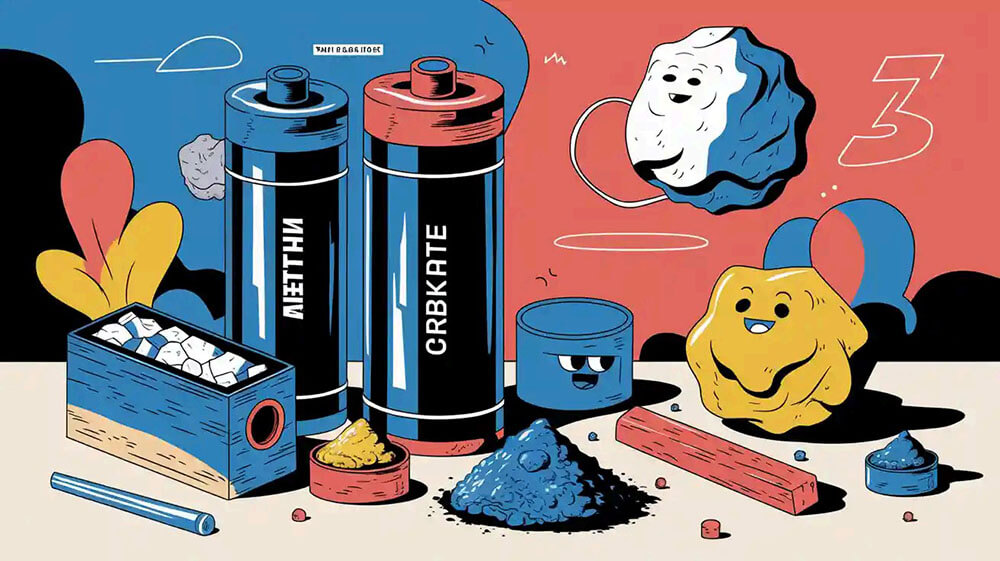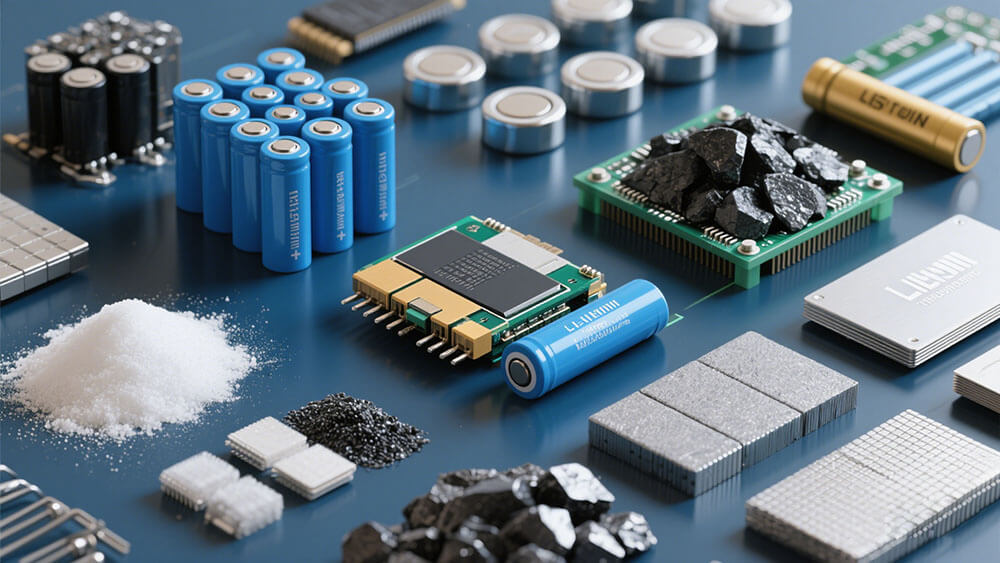Contents

Lithium-ion batteries have revolutionized industries by meeting the increasing demand for efficient energy storage solutions. In 2023, consumer electronics alone accounted for over 31% of the global lithium-ion battery market, powering devices like smartphones and laptops. Industrial applications also rely on these batteries for their high power output and safety, while advancements in medical technologies support critical healthcare innovations. The global market, valued at $48.1 billion in 2023, is projected to reach $165.4 billion by 2032, underscoring the growing dependence on the materials of lithium battery for sustainable growth.
Key Takeaways
Lithium is the main part of lithium-ion batteries. It helps store energy and powers many devices in different fields.
Cobalt makes batteries stable and stores more energy. However, it is important to get it responsibly because of mining labor issues.
Nickel helps batteries hold more energy, which is key for electric cars. Graphite is used as the main anode material and conducts electricity well.

Part 1: Key Materials of Lithium Battery
1.1 Lithium: The Core Component for Energy Storage
Lithium serves as the backbone of lithium-ion batteries, enabling efficient energy storage and discharge. Its lightweight nature and high electrochemical potential make it indispensable for powering devices across industries. From medical equipment to robotics, lithium ensures reliable performance and longevity. The element facilitates ion migration between the anode and cathode, a process critical for energy storage and release. Without lithium, the high energy density that defines modern batteries would not be achievable.
The demand for lithium continues to rise, driven by its application in electric vehicles and renewable energy systems. According to market data, lithium-ion batteries accounted for over 70% of lithium consumption globally in 2022. This trend highlights the importance of securing sustainable lithium sources to meet future energy needs.
1.2 Cobalt: Enhancing Stability and Energy Density
Cobalt plays a pivotal role in stabilizing cathodes and enhancing the energy density of lithium-ion batteries. It ensures that batteries can store significant amounts of energy while maintaining thermal stability. This characteristic is particularly vital for applications like medical devices, where safety and performance are paramount.
“In most lithium-ion batteries, the cathode contains cobalt, a metal that offers high stability and energy density. Cobalt batteries can store a lot of energy, and they have all of the features that people care about in terms of performance…”
Despite its benefits, cobalt sourcing poses ethical challenges. The Democratic Republic of Congo supplies over 70% of the world’s cobalt, raising concerns about labor practices and environmental impact. Addressing these issues is crucial for the sustainable development of battery technologies.
1.3 Nickel: Boosting Energy Storage Capacity
Nickel is integral to increasing the energy storage capacity of lithium-ion batteries. It is a key component in NMC (Nickel Manganese Cobalt) cathodes, which are widely used in robotics. Nickel’s high energy density and rapid charging capabilities make it essential for sustainable usage time solutions.
For instance, NMC lithium batteries with higher nickel content offer extended ranges for robotics, making them a preferred choice for manufacturers like Robot Companion. This innovation underscores nickel’s role in advancing battery technology and supporting the transition to cleaner energy systems.
1.4 Graphite: The Primary Anode Material
Graphite serves as the primary anode material in lithium-ion batteries, offering excellent conductivity and cycle life. Its microstructure significantly influences lithium-ion diffusion kinetics and storage capacity. Additives like carbon black and carbon nanotubes further enhance its performance, ensuring durability and efficiency.
Graphite outperforms other materials in conductivity, making it a reliable choice for anodes.
The addition of carbon black improves charge/discharge rates and structural integrity during cycling.
Its role in enhancing battery performance is critical for applications in consumer electronics and industrial systems.
The dominance of graphite in battery materials highlights its importance in achieving efficient and durable energy storage solutions.
1.5 Manganese: Supporting Cathode Performance
Manganese contributes to the stability and energy density of cathodes in lithium-ion batteries. It is a key component in LMO (Lithium Manganese Oxide) and NMC batteries, both of which are known for their high performance. LMO batteries, for example, offer fast charging and discharging capabilities, making them suitable for applications like robotics and security systems.
Manganese’s cost-effectiveness and thermal stability further enhance its appeal. Its inclusion in NMC batteries reduces overheating risks, ensuring safety and reliability. As demand for high-performance batteries grows, manganese’s role in supporting cathode performance becomes increasingly significant.
1.6 Additional Battery Materials: Electrolytes, Binders, and Separators
Beyond the primary components, additional materials like electrolytes, binders, and separators play crucial roles in battery functionality. Electrolytes facilitate ion movement between the anode and cathode, while binders ensure the structural integrity of electrodes. Separators prevent short circuits by keeping the anode and cathode apart.
Function/Characteristic | Description |
|---|---|
Homogenization | Ensures uniform distribution and stability of materials during electrode manufacturing. |
Stable Structure | Acts as a buffer to prevent active substances from falling off or cracking during charging and discharging. |
Improve Performance | Reduces the impedance of the electrode, enhancing overall battery performance. |
Key Properties | Must have stability, solubility, moderate viscosity, and good flexibility to meet performance requirements. |
These materials collectively enhance the efficiency, safety, and longevity of lithium-ion batteries, making them indispensable for modern energy storage solutions.

Part 2: Sourcing and Geographical Distribution of Battery Raw Material
2.1 Lithium: Major Producers in Australia, Chile, and Argentina
Lithium, the cornerstone of energy storage, is primarily sourced from three countries: Australia, Chile, and Argentina. Australia leads global lithium production, contributing 88,000 metric tons in 2024, with significant operations like the Greenbushes mine. Chile follows with 49,000 metric tons, showcasing a remarkable 127% year-over-year growth due to its rich brine deposits in Salar de Atacama. Argentina, with its vast untapped reserves, holds the potential to produce up to 4 million metric tons by 2027. These nations play a pivotal role in meeting the surging demand for lithium-ion batteries, especially for electric vehicles and renewable energy systems.
2.2 Cobalt: Concentration in the Democratic Republic of Congo
Cobalt, essential for stabilizing cathodes in batteries, is predominantly mined in the Democratic Republic of Congo (DRC). The DRC supplies over 70% of the global cobalt demand, making it a critical player in the battery raw material supply chain. However, the region faces challenges related to ethical mining practices and environmental concerns. Addressing these issues is vital for ensuring sustainable and responsible sourcing.
2.3 Nickel: Key Reserves in Indonesia, the Philippines, and Russia
Nickel significantly enhances the energy storage capacity of batteries, particularly in NMC Lithium batteries. Indonesia leads with 21 million tons of reserves, representing 20.6% of global reserves, and produced 1.72 million tons in 2023, marking a 21.1% increase from the previous year. The Philippines contributed 365,100 tons, accounting for 11% of global production, while Russia produced 218,900 tons. These countries are instrumental in supporting the growing demand for electric vehicles and industrial applications.
Indonesia: 21 million tons of reserves, 1.72 million tons produced in 2023 (+21.1% YoY).
Philippines: 365,100 tons produced in 2023, 11% of global production.
Russia: 218,900 tons produced in 2023, slight decrease from 2022.
2.4 Graphite: China’s Dominance in Natural Graphite Production
China dominates the global graphite market, producing 61% of natural graphite and accounting for 98% of the processed material used in battery anodes. Other contributors include Mozambique (12%), Madagascar (8%), Brazil (6%), and India (4%). China’s dominance ensures a steady supply of high-quality graphite for lithium-ion batteries, which is critical for consumer electronics and industrial systems.
China holds 62% of the graphite market share.
Mozambique, Madagascar, Brazil, and India collectively contribute 30%.
China processes 98% of the graphite used in battery anodes.
2.5 Manganese: Mining in South Africa and Gabon
Manganese, vital for cathode performance in LMO and NMC batteries, is primarily mined in South Africa and Gabon. South Africa leads with 7.4 million metric tons of production and 560 million metric tons of reserves. Gabon follows with 4.6 million metric tons of production. These countries ensure a stable supply of manganese for high-performance batteries used in robotics and security systems.

Part 3: Challenges and Sustainability in Battery Materials
3.1 Environmental and Ethical Concerns in Mining
Mining raw materials for batteries, such as cobalt, nickel, and lithium, often leads to significant environmental and ethical challenges. Extracting these resources disrupts ecosystems, contaminates water supplies, and contributes to deforestation. A study on Arctic mining regions highlights how land use conflicts and environmental alterations arise from mining activities. It also emphasizes the importance of remediation measures to restore ecosystems and mitigate long-term damage. These findings underscore the need for sustainable mining practices to minimize ecological harm.
Ethical concerns also dominate the conversation, particularly in regions like the Democratic Republic of Congo, where over 70% of the world’s cobalt is sourced. Reports of child labor and unsafe working conditions in artisanal mines raise serious questions about the human cost of battery production. Addressing these issues requires stricter regulations, third-party audits, and increased transparency in supply chains. Companies must prioritize ethical sourcing to align with global sustainability goals.
3.2 Supply Chain Vulnerabilities and Geopolitical Risks
The battery industry faces significant supply chain vulnerabilities due to the geographical concentration of raw materials. For instance, over 60% of natural graphite is produced in China, while Indonesia dominates nickel reserves. This reliance on a few countries creates risks related to political instability, trade restrictions, and natural disasters.
Several studies provide insights into these risks:
Yuan et al. analyzed how resource recovery rates and substitutability impact supply risks for critical metals.
Anish et al. used the GeoPolRisk method to assess how political stability affects the supply of metals in OECD countries.
Zhang et al. highlighted how political instability in mining nations disrupts the supply chain for solar panel materials.
Wang and Tao concluded that improved China-ASEAN relations enhance trade opportunities, reducing supply chain vulnerabilities.
Diversifying sourcing strategies and investing in local production capabilities can mitigate these risks. Companies must also adopt advanced forecasting tools to anticipate and address potential disruptions.
3.3 Recycling and Second-Life Applications for Battery Raw Material
Recycling and second-life applications offer promising solutions to reduce dependency on virgin raw materials. Recycling facilities, however, remain concentrated in East Asia, which accounted for two-thirds of global capacity in 2021. This geographical imbalance limits recycling efficiency in regions like the US and EU.
Aspect | Details |
|---|---|
Recycling Capacity | Historically limited in the US and EU, with two-thirds located in East Asia as of 2021. |
Economic Feasibility | Recycling is economically viable for valuable materials, but less so for LiFePO4 batteries. |
Second-Life Applications | Repurposing used batteries can generate additional revenue and reduce waste management costs. |
Second-life applications, such as repurposing batteries for energy storage systems, extend the lifecycle of materials and reduce waste. For example, used batteries from electric vehicles can power renewable energy grids, offering both economic and environmental benefits. Companies must invest in advanced recycling technologies and establish partnerships to scale these initiatives. Learn more about sustainability efforts from Large Power.
3.4 Innovations in Material Alternatives and Reduction of Critical Metals
Innovations in battery technology aim to reduce reliance on critical metals like cobalt and nickel. Researchers are exploring alternative materials, such as manganese-rich cathodes and solid-state electrolytes, to enhance performance and sustainability. Solid-state batteries, for instance, offer higher energy densities (300–500 Wh/kg) and improved safety compared to traditional lithium-ion batteries.
Efforts to develop cobalt-free or low-cobalt batteries, such as LiFePO4 Lithium batteries, also show promise. These batteries provide a platform voltage of 3.2V and a cycle life of 2,000–5,000 cycles, making them suitable for industrial and infrastructure applications. Additionally, advancements in recycling technologies enable the recovery of valuable materials, further reducing the need for virgin resources.
By adopting these innovations, the battery industry can achieve greater sustainability while meeting the growing demand for electric vehicles and renewable energy systems. Companies like Large Power offer customized solutions to help businesses transition to greener energy storage technologies. Explore our custom battery solutions from Large Power.
Lithium-ion batteries depend on critical raw materials like lithium, cobalt, nickel, graphite, and manganese. Each material contributes uniquely to the battery’s performance, ensuring reliability for applications in medical devices, robotics, and infrastructure. However, sourcing these materials involves environmental and ethical challenges. For example, studies reveal that Europe faces significant demand for EV battery materials, while the United States assesses potential supply risks from lithium-ion battery waste flows.
Sustainability efforts, such as recycling and material innovation, are essential for reducing dependency on virgin resources. Recycling initiatives, particularly in East Asia, and advancements like solid-state batteries with energy densities of 300–500 Wh/kg, demonstrate the industry’s commitment to greener solutions. By understanding these materials and adopting sustainable practices, you can support the transition to a cleaner economy. Explore custom battery solutions tailored to your needs from Large Power.
FAQ
1. What industries benefit the most from lithium-ion batteries?
Lithium-ion batteries power industries like medical, robotics, infrastructure, and consumer electronics, offering high energy density and reliability for critical applications.
2. How does Large Power support custom battery solutions?
Large Power provides tailored lithium-ion battery solutions for industrial, medical, and security systems, ensuring optimal performance and compliance with industry standards.
3. What are the sustainability efforts in lithium-ion battery production?
Efforts include recycling, second-life applications, and material innovation. Learn more about sustainability initiatives here.





